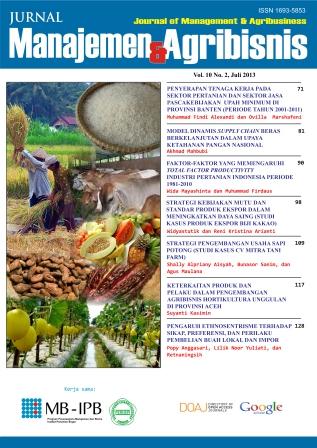PENGARUH ETHNOSENTRISME TERHADAP SIKAP, PREFERENSI DAN PERILAKU PEMBELIAN BUAH LOKAL DAN IMPOR
Abstract
ABSTRACT
The purpose of this research were to 1) analyze the effect of ethnocentrism towards income and educational level; 2) analyze the effect of ethnocentrism on consumers' attitudes; 3) analyze the effect of ethnocentrism on purchasing behavior; 4) analyze the effect of ethnocentrism on consumers’ preferences; and 5) formulate marketing strategies of local fruits. The study used a survey approach with descriptive study design and cross sectional study. Data were collected through questionnaires with non probability sampling technique using convenience sampling technique. Consumer ethnocentrism was measured by the consumer ethnocentrism scale. Data were analyzed using structural equation modeling. The results of this study showed that 49,33% of respondents had medium ethnocentrism level. Ethnocentrism has a positive and significant relationship to preferences and buying behavior. Strategy recommendations were made based on the research findings. The fruits need to be segmented by the grade; higher price should be given to the fruit with good quality and attractive appearance, while fruits with lower quality should be given appropriate price.
Keywords: ethnocentrism, attitude, preference, purchasing behavior, fruits, structural equation modeling (SEM)
ABSTRAK
Tujuan daripenelitian ini adalah 1) menganalisis pengaruh hubungan ethnosentrisme terhadap pendapatan dan tingkat pendidikan, 2) menganalisis pengaruh etnosentrisme untuk sikap konsumen, 3) menganalisis pengaruh etnosentrisme untuk perilaku pembelian, 4) menganalisis pengaruh etnosentrisme untuk konsumen preferensi, dan 5) merumuskan strategi pemasaran buah-buahan lokal. Penelitian menggunakan pendekatan survei dengan desain penelitian deskriptif dan cross sectional study. Pengumpulan data dilakukan melalui pengisian kuesioner dengan teknik nonprobability sampling technique menggunakan metode convenience sampling. Etnosentrisme konsumen diukur dengan consumer ethnocentrism scale. Data dianalisis dengan menggunakan structural equation modeling. Hasil penelitian ini menunjukkan bahwa responden 49,33% memiliki tingkat ethnocentricm menengah. Etnosentrisme memiliki hubungan positif dan signifikan terhadapsikap, preferensi, dan perilaku pembelian. Rekomendasi strategi dibuat berdasarkan temuan pada hasil penelitian, yaitu perlu dilakukan pembagian grade buah-buahan, buah yang memiliki kualitas yang bagus dan tampilan yang menarik dihargai mahal dan buah yamg memiliki kualitas kurang bagus diberi harga yang sesuai.
Kata kunci: etnosentrisme, preferensi, perilaku pembelian, buah-buahan, structural equation modeling (SEM)
The purpose of this research were to 1) analyze the effect of ethnocentrism towards income and educational level; 2) analyze the effect of ethnocentrism on consumers' attitudes; 3) analyze the effect of ethnocentrism on purchasing behavior; 4) analyze the effect of ethnocentrism on consumers’ preferences; and 5) formulate marketing strategies of local fruits. The study used a survey approach with descriptive study design and cross sectional study. Data were collected through questionnaires with non probability sampling technique using convenience sampling technique. Consumer ethnocentrism was measured by the consumer ethnocentrism scale. Data were analyzed using structural equation modeling. The results of this study showed that 49,33% of respondents had medium ethnocentrism level. Ethnocentrism has a positive and significant relationship to preferences and buying behavior. Strategy recommendations were made based on the research findings. The fruits need to be segmented by the grade; higher price should be given to the fruit with good quality and attractive appearance, while fruits with lower quality should be given appropriate price.
Keywords: ethnocentrism, attitude, preference, purchasing behavior, fruits, structural equation modeling (SEM)
ABSTRAK
Tujuan daripenelitian ini adalah 1) menganalisis pengaruh hubungan ethnosentrisme terhadap pendapatan dan tingkat pendidikan, 2) menganalisis pengaruh etnosentrisme untuk sikap konsumen, 3) menganalisis pengaruh etnosentrisme untuk perilaku pembelian, 4) menganalisis pengaruh etnosentrisme untuk konsumen preferensi, dan 5) merumuskan strategi pemasaran buah-buahan lokal. Penelitian menggunakan pendekatan survei dengan desain penelitian deskriptif dan cross sectional study. Pengumpulan data dilakukan melalui pengisian kuesioner dengan teknik nonprobability sampling technique menggunakan metode convenience sampling. Etnosentrisme konsumen diukur dengan consumer ethnocentrism scale. Data dianalisis dengan menggunakan structural equation modeling. Hasil penelitian ini menunjukkan bahwa responden 49,33% memiliki tingkat ethnocentricm menengah. Etnosentrisme memiliki hubungan positif dan signifikan terhadapsikap, preferensi, dan perilaku pembelian. Rekomendasi strategi dibuat berdasarkan temuan pada hasil penelitian, yaitu perlu dilakukan pembagian grade buah-buahan, buah yang memiliki kualitas yang bagus dan tampilan yang menarik dihargai mahal dan buah yamg memiliki kualitas kurang bagus diberi harga yang sesuai.
Kata kunci: etnosentrisme, preferensi, perilaku pembelian, buah-buahan, structural equation modeling (SEM)
Authors
AnggasariP., YuliatiL. N., & RetnaningsihR. (2014). PENGARUH ETHNOSENTRISME TERHADAP SIKAP, PREFERENSI DAN PERILAKU PEMBELIAN BUAH LOKAL DAN IMPOR. Jurnal Manajemen Dan Agribisnis, 10(2), 128-136. https://doi.org/10.17358/jma.10.2.128-136
Authors who publish with this journal agree to the following terms:
- Authors retain copyright and grant the journal right of first publication with the work simultaneously licensed under a Creative Commons Attribution License that allows others to share the work with an acknowledgement of the work's authorship and initial publication in this journal.
- Authors are able to enter into separate, additional contractual arrangements for the non-exclusive distribution of the journal's published version of the work (e.g., post it to an institutional repository or publish it in a book), with an acknowledgement of its initial publication in this journal.
- Authors are permitted and encouraged to post their work online (e.g., in institutional repositories or on their website) prior to and during the submission process, as it can lead to productive exchanges, as well as earlier and greater citation of published work (See The Effect of Open Access).

